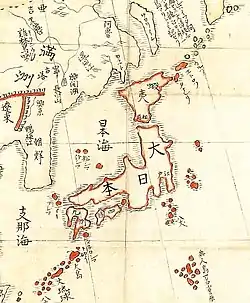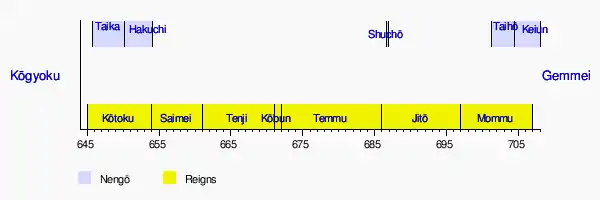Hakuchi (era)
Hakuchi (白雉) was a Japanese era name (年号, nengō, lit. "year name") after the Taika era and before Shuchō. This period spanned the years from February 650 through December 654.[1] The reigning emperor was Kōtoku-tennō (孝徳天皇).[2]
| History of Japan |
|---|
 |
History
The era began in 650, the sixth year of the Taika era, which was thus known as Hakuchi gannen (白雉元年, "Hakuchi start").[3] The daimyō of Nagato Province brought a white pheasant to the court as a gift for the emperor. This white pheasant was then construed as a good omen. Emperor Kōtoku was extraordinarily pleased by this special avian rarity, and he wanted the entire court to see this white bird for themselves. He commanded a special audience in which he could formally invite the sadaijin and the udaijin to join him in admiring the rare bird; and on this occasion, the emperor caused the nengō to be changed to Hakuchi (meaning "white pheasant").[4]
In Japan, this was the second nengō,[1] derived from the Chinese system of eras (nianhao);[5] although some scholarly doubt has been cast on the authenticity of Taika and Hakuchi as historically legitimate era names.[6]
Events of the Hakuchi era
- 650 (Hakuchi 1): Kōtoku commanded that all prisoners were to be granted liberty throughout the country.[4]
- 654 (Hakuchi 5, 1st month): A great number of rats moved into the province of Yamato; and this was construed as a sign that the capital should be moved.[3]
- 654 (Hakuchi 5): Kōtoku died at the age of 59 after a reign of 10 years—five years during Taika, and five years during Hakuchi.[7]
Notes
- Nussbaum, Louis-Frédéric. (2005). "Hakuchi" in Japan Encyclopedia, p. 280, p. 280, at Google Books; n.b., Louis-Frédéric is pseudonym of Louis-Frédéric Nussbaum, see Deutsche Nationalbibliothek Authority File Archived 2012-05-24 at Archive.today.
- Titsingh, Isaac. (1834). Annales des empereurs du japon, pp. 47-50., p. 47, at Google Books
- Brown, Delmer et al.. (1979). Gukanshō, p. 267.
- Titsingh, p. 49.
- Nussbaum, "Taika" at p. 924, p. 9247, at Google Books
- Bialock, David T. (2007). Eccentric Spaces, Hidden Histories: Narrative, Ritual, and Royal Authority from the Chronicles of Japan to the Tale of the Heike, pp. 56–57, p. 56, at Google Books; excerpt at p. 57, "Whether the era name of Taika and Hakuchi are viewed as evidence of an actual precedent set by Kōtoku or as the work of chroniclers belonging to a later reign around the time of Nihon Shoki 's editing, the practice of assigning era names inaugurated a new phase in the consolidation of the court's expanding political power."
- Varley, H. Paul. (1980). Jinnō Shōtōki, p. 133; Titsingh, p. 50.
References
- Bialock, David T. (2007). Eccentric Spaces, Hidden Histories: Narrative, Ritual, and Royal Authority from the Chronicles of Japan to the Tale of the Heike. Stanford: Stanford University Press. ISBN 9780804751582 ISBN 0804751587; OCLC 237216457
- Brown, Delmer M. and Ichirō Ishida, eds. (1979). Gukanshō: The Future and the Past. Berkeley: University of California Press. ISBN 978-0-520-03460-0; OCLC 251325323
- Nussbaum, Louis-Frédéric and Käthe Roth. (2005). Japan encyclopedia. Cambridge: Harvard University Press. ISBN 978-0-674-01753-5; OCLC 58053128
- Titsingh, Isaac. (1834). Nihon Odai Ichiran; ou, Annales des empereurs du Japon. Paris: Royal Asiatic Society, Oriental Translation Fund of Great Britain and Ireland. OCLC 5850691
- Varley, H. Paul. (1980). A Chronicle of Gods and Sovereigns: Jinnō Shōtōki of Kitabatake Chikafusa. New York: Columbia University Press. ISBN 9780231049405; OCLC 6042764
External links
- National Diet Library, "The Japanese Calendar" -- historical overview plus illustrative images from library's collection
| Preceded by Taika |
Era or nengō Hakuchi 650–652 |
Succeeded by — |
| Preceded by — |
Imperial reign dates Kōtoku period 645–654 |
Succeeded by Saimei period 655–661 |
